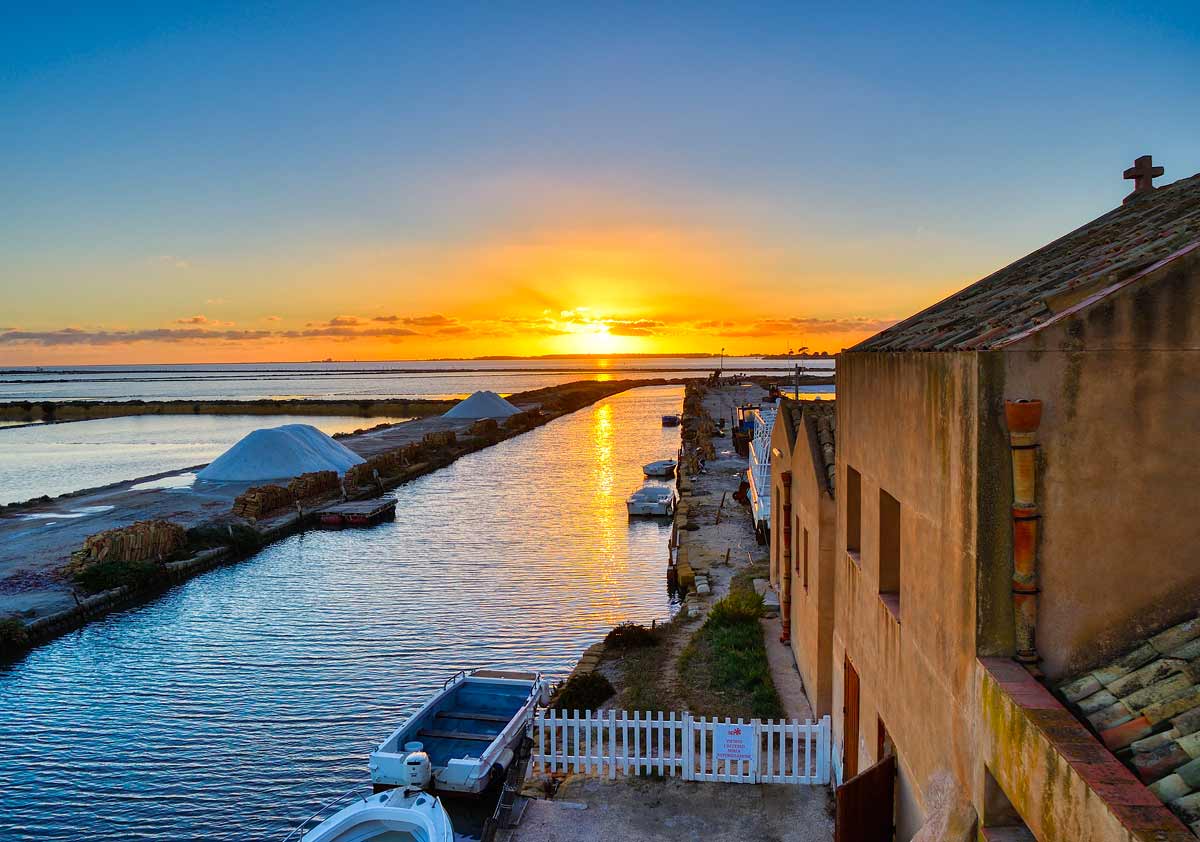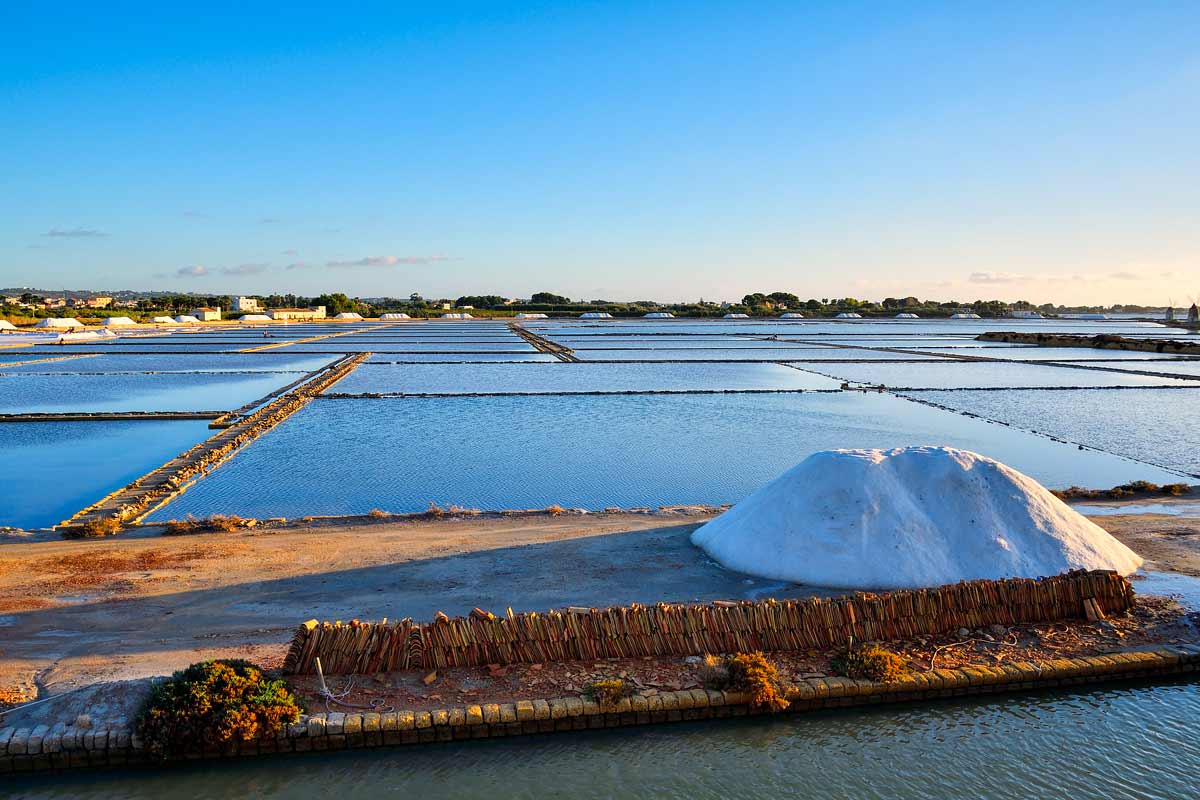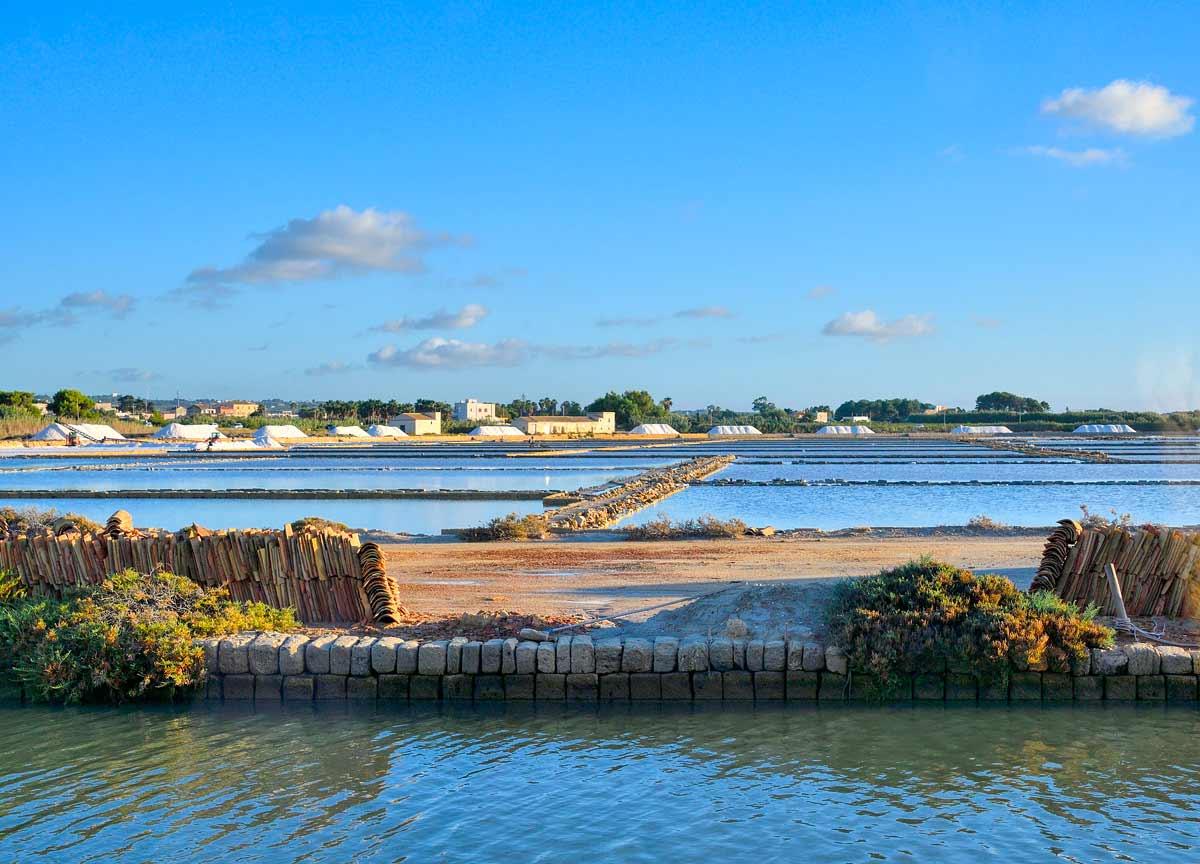Suggestive salt mountains lying on placid lagoons, villages rich in history and crossroads of peoples, majestic nature with the blue sea as a backdrop: we are in the province of Trapani, in the westernmost part of Sicily.
The itinerary, to be covered in at least four days to enjoy unhurriedly the wonders the island has to offer, is mostly easy with a few more challenging sections and runs mainly on paved roads for a total of about 180 km.

With its imposing Spanish fortifications dating back to the 16th century, a historic center dotted with splendid Baroque and neoclassical palaces, and a beautiful waterfront that invites romantic strolls at sunset, Trapani is not only the starting point of our itinerary, but an interesting city to explore. A perfect prelude to the Via del Sale: 29 km of rare and poetic beauty to admire while riding our bike.
The easy, flat route begins along the provincial road sp21 of Trapani, among white salt pans and picturesque windmills that follow one another in a crescendo of emotions first within the Saline di Trapani e Paceco Nature Reserve, and then, near Marsala, in that of the Stagnone.

The first stop is Nubia, where we stop to visit the Salt Museum and learn, thus, about the Phoenician origins of the very ancient tradition of salt pans. The shallow waters on the one hand and the high temperatures accompanied by the presence of wind on the other appeared, in fact, to the Phoenician people ideal conditions for the extraction of salt. Large-scale consumption of this precious element and its use for food preservation soon decreed its success: salt began, thus, to be exported throughout the Mediterranean basin and became a pivotal element of the local economy in later eras as well.
The museum shows the different stages of salt processing and the tools used for extraction and harvesting, but the small Trapani hamlet also boasts another product that, though less well known, is characterized by its high quality: red garlic from Nubia. Inevitable in local recipes, such as in the famous pesto alla Trapanese – made with garlic, tomato, almonds, oil, salt and pepper – with which the traditional busiate, a symbolic dish of the Trapani area, are seasoned, Nubia garlic is distinguished by its red color inside, its intense flavor and its packaging in large braids, which are traditionally hung on balconies.

It is, however, in the vicinity of Marsala, in the brand new Stagnone bike path, that we skirt the most striking and spectacular part of the route. The landscape preserves the history and beauty of these places, between the sixteenth-century red roofs of the windmills and the marshy and brackish areas populated by more than 170 species of birds and by flamingos, revealing to our eyes the perfect combination of nature and man’s work. In the background are the four islands of the lagoon: Isola Longa, the largest; Santa Maria, covered in vegetation; San Pantaleo, the most important because of the ancient Phoenician city of Mozia; and the decadent islet of Schola.
We stop at the beautiful location of the Genna Salt Works to admire, “pieds dans l’eau,” an unforgettable sunset: before us the colorful palette of colors created by the reflection of the sun on the water mirrors of the salt crystallization tanks.

Leaving one of Italy’s most evocative cycle routes behind us, we continue to Capo Boeo, the extreme western tip of Sicily where, in a strategic position on the Mediterranean, stands Marsala, the ancient Marsa Allah (port of God) for the Arabs. The city was the scene of an important moment in the Italian Risorgimento: it was here, in fact, that Garibaldi landed in 1860, as the monument to the Thousand on the seafront recalls. However, what really made Marsala famous were the British shortly before, who in the 18th century discovered the wine vocation of these lands, opening the door to the export of the famous wine throughout Europe.
In fact, history attributes the birth of Marsala to English merchant John Woodhouse, who during one of his travels was struck by a sudden cloudburst and forced to take shelter in Marsala. Here, the local wine must have seemed to him so similar to those in vogue in his land at the time, Port and Madeira, that he wanted to introduce it to English salons. In order to make the long journey, however, he decided to dilute it with aquavit: thus Marsala was born. Not to be missed is the tasting in one of the area’s historic and excellent wineries, such as Fina, Martinez or Pellegrino, which well prepares us for the strenuous climb to Salemi, our next stop, to which we arrive intoxicated by the beauty of the vineyards and olive groves that surround us.
The medieval town, which stands majestically in the heart of the Belice Valley, is built around the Norman castle from which Garibaldi hoisted the tricolor flag proclaiming Salemi the first capital of Italy on May 14, 1860. Counted among the most beautiful villages in Italy, Salemi owes its charm not only to its enviable location but also to the “campanedda” stone, a particular sandstone visible in the buildings of the Jewish quarter of Giudecca and the Arab quarter of Rabato and in no fewer than 25 churches in the historic center, which in sunlight take on warm hues ranging from yellow to pink. Inscribed since 2012 in UNESCO’s Register of Intangible Heritage, the campanedda was so renamed because of the sound emitted when the stonemason strikes, which would resemble that of a bell.
After admiring the splendid view from the castle, we indulge in a short stop for a taste of one of the delicacies of these areas: the “Vastedda del Belice,” a Slow Food Presidium, whose name derives from its shape reminiscent of the traditional Sicilian loaf of bread, the “vastedda.” The only stretched-curd sheep’s milk cheese, it is excellent eaten fresh, dressed with oil, or in typical baked pasta timbales.
We continue through rows of vineyards, wheat fields and streams toward Mount Barbaro, where one of Sicily’s great archaeological wonders stands: the city of Segesta, which dominates the valley with an extraordinary panorama of the Sicilian countryside. Founded by the Elymians, one of the oldest indigenous peoples who lived in western Sicily between the 9th and 1st centuries B.C., it has among its main attractions the theater, where in fine weather it is a must to watch the performance of Greek tragedies while in the background the first lights of dawn give the setting a surreal atmosphere.
From the fascinating and lonely hinterland we point to the northwest coast of the island to reach the village of Castellammare del Golfo. This pretty Arab-Norman town, enclosed between the turquoise waters of the Tyrrhenian Sea and Mount Inici, is nestled among ash trees, oaks and holm oaks in a richly vegetated landscape whose profile is outlined by caves and jagged inlets.
The itinerary continues through the 27 km that separate us from the seaside village of Scopello: an unmissable gem set on a promontory overlooking the sea. The Faraglioni in the background and the bucolic and grandiose landscape in the interior enhance its scenic impact. Once known for its tuna fishery, today the village is mainly known for its beauty and for its access to one of the most beautiful and unspoiled places in Sicily, the Zingaro Nature Reserve: 7 km of disruptively beautiful coastline, amid the intense green of the Mediterranean scrub and the different shades of blue that lap the white beaches of its seven coves. We get out of the saddle to immerse ourselves in this paradise, which can only be visited on foot.
On the west side of the Zingaro Nature Reserve, San Vito lo Capo is famous for the Cous Farallon Festival held every year at the end of summer and hosting chefs from all Mediterranean countries, ready to compete to elect the best Cous Cous.
We continue on the coastal road that, passing through the scenic landscape of Macari and the farming village of Castelluzzo, leads us to the Mount Cofano Reserve, the penultimate stop on our itinerary. The red background of the initial dirt road contrasts with the green of the dwarf palms and the white of the rocks, which soon give way to coves and inlets with crystal-clear waters. Beyond Punta del Saraceno, to the southwest, the walls become steeper and overhanging the sea, and the trail becomes harder and rougher. To refresh us, however, a delicious pane cunzato with tomato, olives, capers and mozzarella awaits us at the end of the trail, before the challenging climb to the last stage: Erice.
Situated 750 meters above sea level on the summit of Mount San Giuliano, this beautiful and majestic medieval village offers incredible panoramic views of Trapani and the Gulf of Macari, which will reward the energy expended in tackling the challenging elevation gain.
Founded by the Elymians, to whom the cyclopean walls that outline the perimeter of the town date, Erice was later conquered by the Phoenicians, Romans and Normans. To the latter dates the Castle of Venus, built in the same place where an ancient pagan temple dedicated to the cult of the goddess stood: inside it one can still admire a well in which, according to legend, Venus herself bathed immersed in milk.
A slow walk through the village’s cobblestone streets leads us to the Pepoli Turret, a beautiful Art Nouveau palace built by Agostino Pepoli at the end of the 19th century, from which there is a panorama that embraces the entire gulf as far as Mount Cofano.
We end our itinerary with a gourmand break at Maria Grammatico’s, a true institution of Erice pastry making. Here Sicilian opulence manifests itself in a triumph of colors and flavors, a worthy and well-deserved conclusion to this unforgettable Sicilian weekend.
